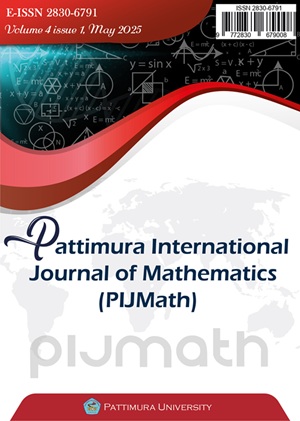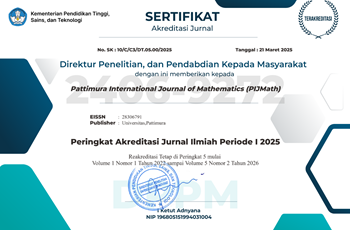Factor Analysis on Poverty in Kalimantan Island with Geographically Weighted Negative Binomial Regression
Abstract
Poverty is one of the problems still faced by Indonesia. The problem of poverty is a development priority because poverty is a complex and multidimensional problem. Therefore, to reduce poverty, it is necessary to know the factors that influence the number of people living in poverty. The influencing factors in each region are different due to the effects of spatial heterogeneity between regions such as geographical, economic, and socio-cultural conditions. This research considers spatial factors by using the Geographically Weighted Negative Binomial Regression (GWNBR) method on poverty-based regions in Kalimantan Island. This research uses eleven independent variables. The weighting function used is the Adaptive gaussian kernel because the adaptive kernel can produce the number of weights that adjust to the distribution of observations. The stage starts with descriptive statistics and checking multicollinearity. Then proceed with the formation of Poisson Regression, because the data used is enumerated data. Then check for overdispersion. If overdispersion is detected where the variance is bigger than the mean, then Negative Binomial Regression is continued. After that, it is tested for the presence or absence of spatial heterogeneity. If there is, proceed to find the bandwidth and Euclidean distance. After that, the graphical weighting matrix is searched. Then proceed with GWNBR modeling. The results of the analysis show that there are seven significant variables, including the percentage of households with the main source of lighting is non-state electricity company (PLN), average monthly net income of informal workers, population density for every square kilometer, monthly per capita expense on food and non-food essentials, percentage of people who have a health complaint and do not treat it because there is no money and percentage of population 15 years and above who do not have a diploma. Based on the categories of significant variables, six groups were formed in 56 districts/cities in Kalimantan Island.
Downloads
References
Atno Parluhutan Sinaga, A. (2022). POVERTY PERSPECTIVES AND REDUCTION STRATEGIES IN INDONESIA. Three Seas Economic Journal, 3(3), 1–9. https://doi.org/10.30525/2661-5150/2022-3-1
Hermawan, I., Mulya Firdausy, C., Rizqy Rambe, K., Zuhdi, F., Erwidodo, Dewi Nugraheni, R., Malisan, J., Isnasari, Y., Marpaung, E., & Milawati Asshagab, S. (2024). Road traffic facilities, traffic accidents, and poverty: Lesson learned from Indonesia. Transportation Research Interdisciplinary Perspectives, 28(July), 101273. https://doi.org/10.1016/j.trip.2024.101273
Jasmadi, I., Widodo, D. A., & Oktaviana, P. P. (2016). Pemodelan dan Pemetaan Kasus Jumlah Penduduk Miskin di Provinsi Jambi pada Tahun 2014 dengan Menggunakan Geographically Weighted Negative Binomial Regression. Jurnal Sains dan Seni ITS, 5(2), 350–354. https://doi.org/http://dx.doi.org/10.12962/j23373520.v5i2.16704
Wiratama, B. F., Kurniawan, R., Mulyanto, Isnaeni, M. A., Sumargo, B., & Gio, P. U. (2023). Measuring the physical infrastructure development as poverty reduction program in Kalimantan, Indonesia. Cities, 141, 104515. https://doi.org/10.1016/j.cities.2023.104515
Halida, A., Salam, N., & Lestia, A. S. (2021). Modeling of poverty in Kalimantan with nonparametric spline regression approach. Journal of Physics: Conference Series, 2106(1), 012008. https://doi.org/10.1088/1742-6596/2106/1/012008
Winata, H. M. (2023). Mengatasi Overdispersi Dengan Regresi Binomial Negatif Pada Angka Kematian Ibu Di Kota Bandung. Jurnal Gaussian, 11(4), 616–622. https://doi.org/10.14710/j.gauss.11.4.616-622
Delvia, N., Mustafid, M., & Yasin, H. (2021). Geographically Weighted Negative Binomial Regression Untuk Menangani Overdispersi Pada Jumlah Penduduk Miskin. Jurnal Gaussian, 10(4), 532–543. https://doi.org/10.14710/j.gauss.v10i4.33106
Fitriani, R., & Gede Nyoman Mindra Jaya, I. (2020). Spatial modeling of confirmed COVID-19 pandemic in East Java Province by geographically weighted negative binomial regression. Communications in Mathematical Biology and Neuroscience, 2020, 1–17. https://doi.org/10.28919/cmbn/4874
Zubedi, F., Aliu, M. A., Rahim, Y., & Oroh, F. A. (2021). Analisis Faktor-Faktor Yang Mempengaruhi Stunting Pada Balita Di Kota Gorontalo Menggunakan Regresi Binomial Negatif. Jambura Journal of Probability and Statistics, 2(1), 48–55. https://doi.org/10.34312/jjps.v2i1.10284
Octavianus Halim, A., & Imro’ah, N. (2024). Negative Binomial Regression in Overcoming Overdispersion Poverty Data in Kalimantan. Jurnal Forum Analisis Statistik (FORMASI), 4(1), 1–10. https://doi.org/10.57059/formasi.v4i1.67
Selvia, E., Imro’ah, N., & Andani, W. (2023). Pemodelan Jumlah Siswa Putus Sekolah Menggunakan Metode Geographically Weighted Negative Binomial Regression. Buletin Ilmiah Math. Stat. dan Terapannya (Bimaster), 12(4), 335–344.
Priambodo, B. W. Y., & Irhamah, I. (2019). Pemetaan Jumlah Property Crime di Provinsi Jawa Timur Menggunakan Metode Geographically Weighted Negative Binomial Regression (GWNBR) dan Geographically Weighted Poisson Regression (GWPR). Inferensi, 2(2), 53. https://doi.org/10.12962/j27213862.v2i2.6818
Fitrial, N. H., & Fatikhurrizqi, A. (2020). Pemodelan Jumlah Kasus COVID-19 di Indonesia dengan Pendekatan Regresi Poisson dan Regresi Binomial Negatif. 1. https://doi.org/https://doi.org/10.34123/semnasoffstat.v2020i1.465
Suryadi, F., Jonathan, S., Jonatan, K., & Ohyver, M. (2023). Handling overdispersion in poisson regression using negative binomial regression for poverty case in west java. Procedia Computer Science, 216, 517–523. https://doi.org/10.1016/j.procs.2022.12.164
Santi, V. M., & Rahayuningsih, Y. (2023). Negative Binomial Regression in Overcoming Overdispersion in Extreme Poverty Data in Indonesia. Pattimura International Journal of Mathematics (PIJMath), 2(2), 43–52. https://doi.org/10.30598/pijmathvol2iss2pp43-52
Fadilah, F. W. R., Handajani, S. S., Zukhronah, E., & Pratiwi, H. (2019). Geographically weighted negative binomial regression model to analysis of factors that influence on maternal mortality in Central Java Province. AIP Conference Proceedings, 2202, 1–6. https://doi.org/10.1063/1.5141718
Wahyuni, L. (2021). Analisis Faktor-Faktor Risiko yang Mempengaruhi Jumlah Kasus Tuberkulosis (TBC) di Provinsi Jawa Barat Tahun 2018 Menggunakan Pendekatan Geographically Weighted Negative Binomial Resgression (GWNBR). https://repository.uinjkt.ac.id/dspace/handle/123456789/56263%0Ahttps://repository.uinjkt.ac.id/dspace/bitstream/123456789/56263/1/LELY WAHYUNI-FST.pdf
Fauwziyah, F., Astutik, S., & Pramoedyo, H. (2022). Geographically Weighted Negative Binomial Regression Modeling using Adaptive Kernel on the Number of Maternal Deaths during Childbirth. Mathematics and Statistics, 10(5), 1133–1139. https://doi.org/10.13189/ms.2022.100525
Zhang, L., Cheng, J., & Jin, C. (2019). Spatial interaction modeling of OD flow data: Comparing geographically weighted negative binomial regression (GWNBR) and OLS (GWOLSR). ISPRS International Journal of Geo-Information, 8(5). https://doi.org/10.3390/ijgi8050220
Suryani, I., Yasin, H., & Kartikasari, P. (2021). Pemodelan Jumlah Kasus Demam Berdarah Dengue (Dbd) Di Jawa Tengah Dengan Geographically Weighted Negative Binomial Regression (Gwnbr). Jurnal Gaussian, 10(1), 136–148. https://doi.org/10.14710/j.gauss.v10i1.29400
Copyright (c) 2025 Alvin Octavianus Halim, Neva Satyahadewi, Preatin Preatin

This work is licensed under a Creative Commons Attribution-NonCommercial 4.0 International License.
The author(s) hold the copyright of the published article without restriction. This policy means that the journal allows the author(s) to hold and retain publishing rights without restrictions.
The author(s) holds the copyright of published articles without limitation. This policy means that the journal allows the author to hold and retain publishing rights without restrictions. Journal editors are given the copyright to publish articles in according to agreement signed by the author and also include statement of originality of the article


.jpg)












 This work is licensed under a
This work is licensed under a 